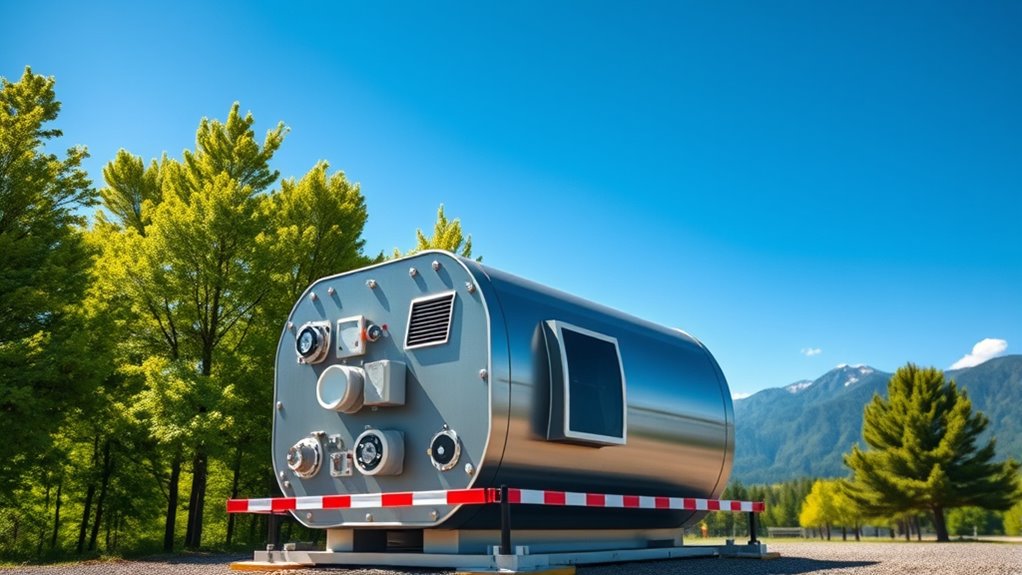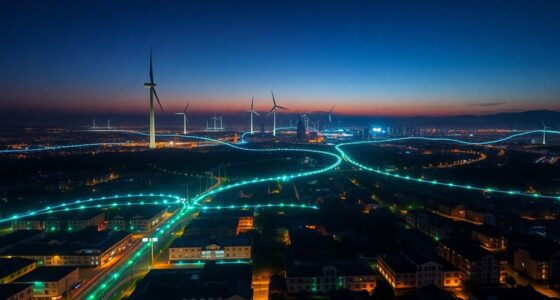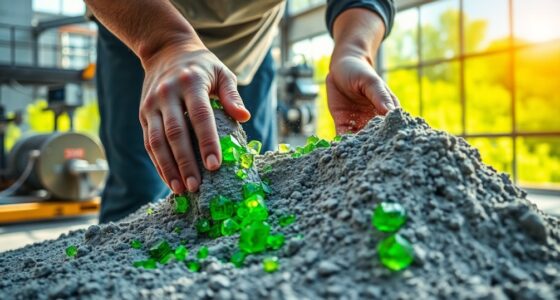Small modular reactors (SMRs) offer a promising future for nuclear energy by providing safer, flexible, and potentially more affordable solutions to meet rising global energy needs. Their factory-built design can accelerate deployment, but regulatory hurdles, high initial costs, and supply chain challenges still exist. If you’re curious about how these innovations could transform the energy landscape and what obstacles remain, exploring further will reveal more about their true potential and impact.
Key Takeaways
- SMRs offer a safer, scalable alternative to traditional nuclear reactors with potential for flexible deployment and reduced costs.
- Regulatory challenges and lengthy approval processes can hinder SMR development and slow market adoption.
- Factory-built modular design aims to lower costs but faces uncertainties due to supply chain and economies of scale.
- SMRs could help meet increasing energy demands while significantly reducing carbon emissions.
- Supportive policies and streamlined regulation are crucial for accelerating SMRs’ role in future energy systems.

Have you ever wondered how small modular reactors could revolutionize the future of nuclear energy? These compact, factory-built units promise a new era of cleaner, safer, and more flexible power generation. Yet, their path to widespread adoption isn’t without hurdles. One of the biggest obstacles lies in regulatory challenges. Unlike traditional large reactors that benefit from well-established frameworks, small modular reactors (SMRs) face a complex maze of licensing procedures, safety standards, and regulatory approvals. Since SMRs are relatively new, regulators need to adapt existing rules or create new ones tailored to their unique design and operation. This process can be slow and uncertain, potentially delaying deployment and increasing costs. As a result, developers often encounter a lengthy approval process that can dampen enthusiasm and investment, despite the potential benefits of SMRs.
On the economic front, questions about viability also loom large. Building SMRs in factories and shipping them to sites sounds cost-effective in theory, but the reality can be different. Since these reactors are smaller and newer, their economies of scale aren’t yet fully proven. You might find that the initial capital costs are still significant, especially given the current regulatory landscape and the need for extensive safety testing. Moreover, because SMRs are modular, they offer flexibility in deployment, but that advantage can be offset if market demand or financing options aren’t aligned. Utility companies and investors could hesitate if they see uncertain returns or if the costs of licensing and certification remain high. Additionally, the lack of a well-established supply chain or standardized design across different manufacturers can add to expenses, making it harder for SMRs to compete with more mature energy sources.
Despite these challenges, many see SMRs as a promising solution to meet the world’s growing energy needs while reducing carbon emissions. They’re designed to be safer, more adaptable, and easier to scale up than traditional reactors. But turning that potential into reality depends heavily on resolving regulatory issues and proving their economic viability. Governments and industry players are working to streamline licensing processes and create supportive policies, recognizing that innovation in regulation is essential. If these hurdles are addressed effectively, SMRs could quickly shift from a promising concept to a practical, widespread energy source. The future of nuclear energy may very well hinge on how well we navigate these regulatory and economic challenges to harness the true potential of small modular reactors.
Frequently Asked Questions
What Are the Environmental Impacts of Small Modular Reactors?
You’ll find that small modular reactors have a lower ecological footprint compared to traditional nuclear plants, thanks to their smaller size and efficiency. They produce less waste, making waste management easier and safer. This reduces environmental risks and helps protect ecosystems. Overall, SMRs offer a cleaner energy source with minimal environmental impact, but careful waste management is vital to prevent long-term ecological harm and ensure they remain a sustainable energy option.
How Do SMRS Compare Cost-Wise to Traditional Nuclear Plants?
You’ll find that SMRs are generally more cost-effective than traditional nuclear plants because they have lower construction costs and shorter build times. Their modular design allows for easier scaling and financing, enhancing economic feasibility. While initial investments are smaller, you should consider long-term operational costs and potential savings from quicker deployment. Overall, SMRs offer a promising, more flexible approach to nuclear energy that could be more affordable for many projects.
Are SMRS Suitable for Developing Countries?
You might think small modular reactors aren’t suitable for developing countries, but they can address socioeconomic challenges by providing reliable, scalable energy. While political feasibility can be complex, SMRs offer safer, easier-to-implement solutions compared to traditional plants. Their lower costs and flexibility make them an appealing option, helping to boost economic growth and energy access, even amidst political or infrastructural hurdles.
What Are the Security Concerns Associated With SMRS?
You should be aware that SMRs face security concerns like cybersecurity risks, which could lead to hacking or sabotage. Additionally, proliferation concerns arise because their smaller size and modular design might make it easier for unauthorized groups to access nuclear materials or technology. To mitigate these risks, strict security protocols, advanced cybersecurity measures, and international oversight are vital to guarantee SMRs remain safe and secure.
How Quickly Can SMRS Be Deployed and Scaled?
Think of deploying SMRs as launching a fleet of small ships—quick to set sail but needing careful coordination. The deployment timeline can range from 2 to 10 years, depending on regulatory approvals and construction speed. Scalability challenges include manufacturing capacity and grid integration. While they can be scaled incrementally, the process requires strategic planning to guarantee each unit seamlessly adds to your energy needs without delays.
Conclusion
Imagine a future where tiny, glowing reactors quietly power cities like stars tucked into a cozy night sky. Small modular reactors promise a cleaner, safer energy source, fitting seamlessly into communities like puzzle pieces. As they shimmer on the horizon, they hold the potential to illuminate a sustainable path forward. Embrace this vision—where innovation sparks hope, and the gentle hum of these reactors could become the heartbeat of tomorrow’s energy landscape.









